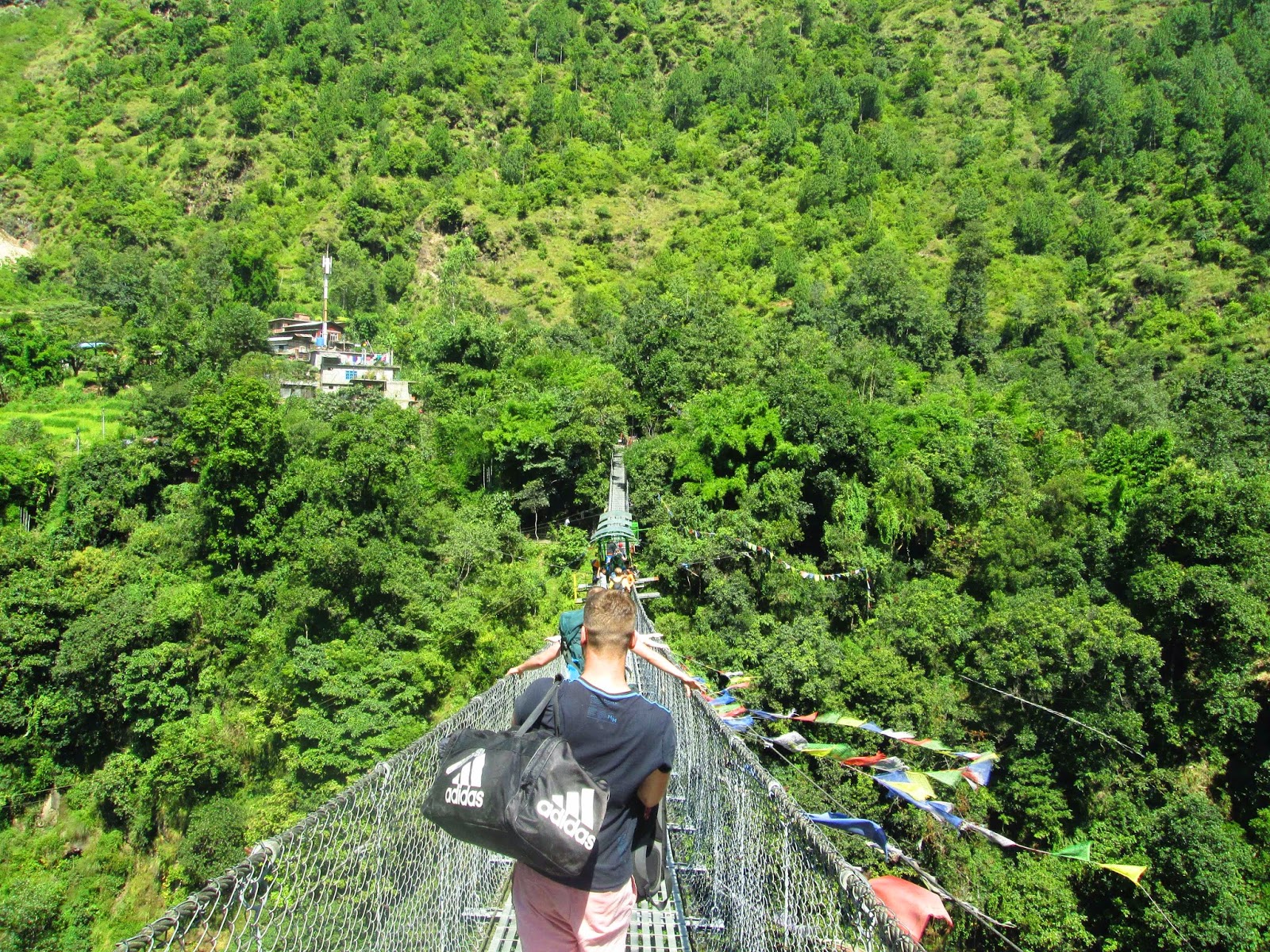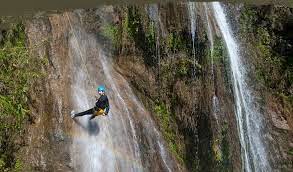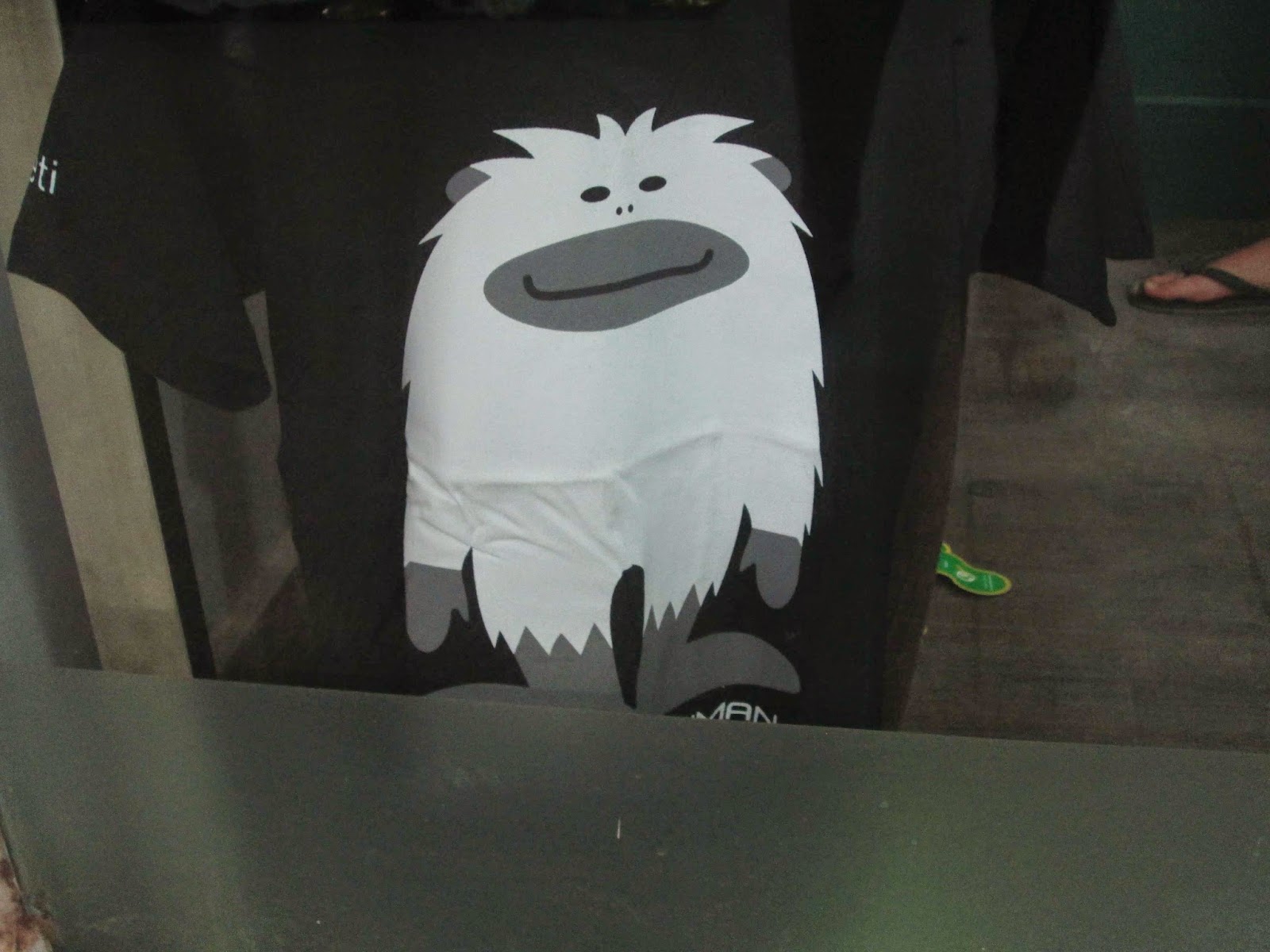There was only one thing that we knew for certain - Lucas, Ross and I were going to meet up during my one week term break in October. The location bounced around from India to Japan to Europe before finally settling on Nepal. Less than three weeks before departure time we asked Cole if he could join. Cole was set to begin his new position at his job in two weeks but nonetheless he asked his new boss if in two weeks, he could have two weeks of vacation. Fortunately Cole's new boss had been to Nepal before and was thrilled about Cole having the opportunity to go there. His boss gave him the time off and told Cole you HAVE to do this trek, you HAVE to go to this place, you HAVE to visit this city. Cole wasn't listening though, and we did none of those things.
We were all so excited for Phase 2 (the name of the house our 6 best friends lived in throughout University) to have their biggest reunion (4/6 members) since graduation that none of us actually took the time to learn anything about Nepal, or what to do when we got there. Cole told his mom we were going on a dive trip, since that's what we always do when we meet up. There is no scuba diving in Nepal. I told my sister we would spend lots of time on the beach. Nepal is landlocked. Ross, Cole and Lucas all packed sweaters and jeans assuming it would be cold. Nepal is like 30 degrees. However no lack of preparation and prior knowledge was going to stop us from having the time of our lives.
I was the last of us to arrive on October 5th and for anyone who has ever been to Nepal you can appreciate how confusing customs is. First you will encounter a large line of tourists at computer stations who are busily typing. You will wait in this line only to later realize this is a passport sized photo taking line and you were smart and brought your own passport photo and didn't actually need to join this line. Next you will exchange your money to Nepal money and remember that (like every new country you've ever visited) you have no idea what the conversion rate is, or how far your dollar gets you, so you must take your best guess at how much money to exchange. Next you will spend your time in the visa line glancing at other tourists, before finally working up the courage to ask them if they have any idea which of the many forms you need to fill out. There will be a suspicious absence of anyone who looks like they might be an employee to help you through this riddle of a situation. Lastly, when you get to the visa counter you will learn that although Nepali customs accepts about 30 different currencies for payment of visa on arrival fee, you will learn that this (astonishingly) does not include the local currency, so you must go back to the exchange counter and re-exchange your exchanged money.
Soon after everything gets much better, right about the time you encounter your first Nepali person. In Nepal the equivalent to saying hello to someone is to smile and say "Namaste". This has to be the most disarming greeting I've ever encountered. This makes it impossible for anyone to be mean or impatient. When you go to a store, a restaurant or anywhere that provides a service you are greeted with "yes please?". Additionally, when speaking to you Nepali people have a very gentle head shake that lets you know they are listening and looks awesome in general. These were my first hints that Nepali people are the politest people I've ever encountered. And this comes from someone who grew up in Canada which has an international reputation for profusely apologizing.
In most touristy countries it is difficult to visit anywhere without being heckled to buy souvenirs, food, massages, anything that can be sold. And the more touristy the area, the more aggressive and impersonal the interactions. In Nepal, this just doesn't happen. And the odd time someone does try to sell you something after the first "no thank you", they will respond with "as you wish" or "that is ok", and then actually not ask you again. This helps to create an incredibly warm and welcoming atmosphere.
One further detail about Nepal that I just can't leave out is that their timezone is staggered by 15 minutes (or 45 depending on which direction you are coming to Nepal from). This makes time zone conversions incredibly more challenging, but does create a nice joke anytime you show up slightly late. "Sorry bro, I forgot about that 15 minutes."
Nepal has the second largest Hindu population in the world, only behind its neighbour India. This religion helps to shape the culture and attitude of Nepali people with their tremendous amount of traditions and beliefs, and unrelenting respect and kindness to everyone and everything. This collective attitude of respect and kindness helps make this country my favourite place I've visited so far.
Despite our lack of planning, I was able to arrange one thing that ended up really making our trip a huge success. I had been put in touch with a local Nepali girl names Bnu (pronounced be-new) through a couple of my teacher friends from Jakarta. With excellent English and an unbelievable passion for Nepal and sharing the beauty of her country with others, Bnu became our personal guide, our friend, and helped make our trip incredibly educational, and incredibly adventurous.
On our first full day in Nepal she took us out to see some sites!
First stop was one of Kathmandu's major religious areas, including temples for prayer and many priests.
The pictures are of some of the Hindu deities. Non-Hindus were not allowed inside the temple area
In Hindu cows are a sacred animal. They are pretty much free to roam where they wish. Many locals will touch the cow on the head then touch their forehead, to bless the cow. This bull almost impaled Ross when he went to take a photo with it.
Also take note of the number of pigeons in the photo. In every country I had previously been to most people either dislike or are indifferent to pigeons. In Nepal they feed them. We asked Bnu why people were feeding the pigeons. She replied "just to be nice". Classic Nepal being nice to everything.
These Indian tourists asked us for a photo. When I first arrived Ross told me about this crazy thing that happened to him where an Asian asked him if she could take a picture with him. 1.5 years and 1.5 million photos with Asians ago I used to understand why Ross would see that as something abnormal.
At one point during our visit Bnu was explaining to us how the cremation ceremonies work. It was fascinating. There are very special white-robed priests who have a very specific role during the cremations of very important people. As part of the ritual, these priests will eat a small portion of the deceased's brain. The priest will then receive enough money from the deceased's family to last for generations, and must leave Nepal, never to return. They will go to another Hindu country, usually India, and continue their spiritual journey.
Then Bnu told us about another type of priest, these ones with orange robes. The conversation went roughly "here is a statue on your left, and on the right are the people who eat the dead bodies, and here on your left we have another. . . ". Hold on one second. What was the part about eating the dead bodies? Yes, when people die, if their bodies aren't claimed, then these priests will eat them. And on the right we have a . . . Hold on I still have more questions about the, do they eat the whole thing?. It wasn't fully clear what the meaning behind this practice was but it was definitely an interesting cultural difference. My understanding is that every part of these traditions is done to help the departed soul to find uninterrupted passage to its next destination, and so that the soul doesn't get lost on its way. Nonetheless Lucas, Cole, Ross and I made a pact that if any of us were to die on this trip we would claim each other.
Next stop was to the city of Bhaktapur. Bhaktapur is considered one of the best preserved medieval kingdoms in Nepal, if not Asia. It was very rich in history and culture.
This use to be the King's bathtub
That's Bnu in the centre of our picture frame
After taking a break and feeding some fish it was time to get some food ourselves. Bnu took us to a nice local place for Nepal's most traditional meal, dal bhat. Dal bhat is served on a metal plate and includes steamed rice, lentil soup (dal), paratha bread or roti, a meat such as chicken, goat or mutton (but never beef), yogurt and a couple other things I can't really name, and served with tea. I highly recommend masala tea. It is awesome! The best part of dal bhat is that it is unlimited refills. They just keep offering to top off each item until you decide that'll be enough. Another traditional Nepali food is called momos. They are similar to dumplings and can be served baked, fried, or half fried. You know, just incase you get cold feet about having them full fried. These are a very tasty treat and make a great appetizer or snack.
Our last touristy stop of the day was Durbar square. Apparently there are lots of places that are called Durbar square and Ross and Lucas accidentally visited the wrong one the day before. This place was full of people lounging around enjoying the peaceful vibe. Bnu told us she use to spend hours hanging out here when she was younger.
Bnu helped us book an adventure package at a place called Last Resort, located 15 minutes from the Tibet border and we headed there the next morning.
In Nepal, which is home to 8 of the 14 highest mountains in the world, everything involves a trek. On our way to Last Resort we had to get off our bus and trek, because a landslide had occurred in the past month. (Actually, this landslide had occurred when my Jakarta friends who put me in touch with Bnu were in Tibet. They had to helicopter over it to get back to Kathmandu for their flight.)
Here is a photo I stole from my Jakarta friend from the helicopter he flew over the landslide in
Landslides are a natural disaster that I've never been in a place where I have ever had to consider. In Nepal, landslides contribute to many deaths each year. In the photos above, and we didn't know this when we were trekking over it, there is an entire village underneath those rocks. You can see the one brick house still standing, but other than that the landslide has left no evidence of the village it has wiped out. It is very eye opening to learn about all of the different natural threats that people in different countries live with.
When we arrived at Last Resort we found a very long, narrow bridge, 200 metres above a very fast-moving river. . .
over looking a beautiful valley.
Don't look down, don't look down, don't look down. . .
Oh no, I looked down.
"camping" out in our tents
Our first day at Last Resort we did a sport I had never heard of before. The website said "canoying", so you can understand why I thought we were going canoeing. But it turns out "canoying", or canyoning is pretty much the most badass thing you can do. It involves scaling down waterfalls into a very beautiful valley.
The right side of the valley is where we canyoned down. The hike back up was much less fun.
These three images are taken from Google since we couldn't bring cameras. This is the actual waterfall we canyoned down.
Remember that bridge from earlier? The one that I think a few people reading this wouldn't even walk across? Now it was time for the four of us to jump off of it. No I am serious.
After once again promising each other that if any of us died, we would claim each other before anyone tries to eat us, it was time to go bungee jumping.
Please check out this link to see!
https://www.youtube.com/watch?v=Lf6nT8A4KZ4&feature=youtu.be
We even got a t-shirt for our efforts!
With shaky legs, and a new understanding of the concept of fear, we hiked back up to the top and left Last Resort.
But canyoning and bungee jumping wouldn't be enough action in 24 hours for adrenaline junkies (apparently) like us, we still had white water rafting to go. I think you can understand why I don't have any photos from this, but we did get a nice group shot afterwards.
Some friends asked me to look out for a yeti in Nepal. I did find one but he was much cuter than I was expecting.
As I mentioned learning earlier in the trip, Nepal is home to Mount Everest. It would be a real shame to come to Nepal and not climb Everest. Being in exceptional physical condition we estimated if we really pushed ourselves it would take about 45 minutes to get to the top and back. So we woke up early in the morning, had a hearty breakfast, and prepared for the journey.
Here is a photo before the altitude sickness kicked in
Climbing Everest is exhausting. Lucas even fell asleep
We were allowed in the cockpit for a larger view
The big one in the middle, that's Everest
All my life I had just been picturing Everest as a really, really tall triangle. And to climb it you would just climb straight up for 8848 metres. I was shocked to hear that 1 in every 4 people who have tried to summit Everest have died in the attempt. Seeing the Himalayan mountain range up close gave me a whole new grasp on how massive and awesome this mountain range is. When the plane landed I found myself shocked knowing that 3 in every 4 people who have tried to summit Everest actually survived.
We even received a certificate for our efforts
After the Everest experience we visited Bnu one more time to thank her for everything and say our goodbyes, although I am pretty confident it is more of an "until next time" since there is so much left to explore in this remarkable country.
Myself, Cole, Bnu, Ross and Lucas
Experiencing what it is like at Bnu's altitude
For my final day in Nepal we signed up for a cooking class with a local family. We left the class having no more Nepali cooking ability than when we showed up but it was an awesome experience spending time with the family, observing how they prepare all the tasty food we had been enjoying over the past few days, and of course filling our bellies with some authentic local cuisine.
Lentil soup (dal)
The Nepali lady who actually did all the important parts of the cooking
They called this pickles, it was excellent
In Nepal they are able to do the impossible, make cauliflower taste good
My favourite food item was the paratha which means potato bread
I've mastered the under the leg rolling pin technique
Cole has mastered the paratha bread flipping technique
Ross has mastered the watching the Nepali lady do it all technique
These are momos
Momos are impossible to make
She kept showing us the momo folding technique
But then unfolding our attempts and folding them up properly
Our final product - some tasty dal bhat
Four happy chefs
It is hard to believe everything I just described and more occurred in less than 120 hours. For showing up not knowing the first thing about Nepal and not having a plan I think we really made every minute count. This is a painting I bought to always remind me of my trip to Nepal.
Before we left we decided to get some custom made t-shirts for the boys. We found a tailor who agreed on our design and wording. I had to fly out that night, and the boys off to the next awesome place, so we asked him if it would be possible to finish the shirts in a few hours and he agreed. When we came back to pick up the shirts he said "just tomorrow". We were pretty disappointed and tried to tell him we told him we can't tomorrow, its gotta be tonight or we want our money back. He said its gotta be tomorrow or not at all. Then his lips slowly curled into a big smile, and laughter came from his tailor friend, as he tossed us the bag of finished t-shirts.
The gentleman next to me is the prankster
Such a great country, such great friends. . . Until next time






































































No comments:
Post a Comment